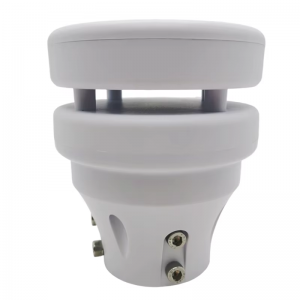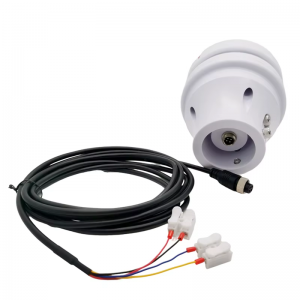Cum continuo progressu scientiae et technologiae, technologia monitoriae meteorologicae etiam singulis diebus mutatur. Sensor ultrasonicus celeritatis et directionis venti, ut novus instrumentum monitorium meteorologicum, paulatim substituit instrumentum mechanicum celeritatis et directionis venti traditionale, cum commodis altae praecisionis, nullius detrimenti mechanici, et monitorii in tempore reali, et novus favor in campo monitorii meteorologici factus est.
Recentibus annis, propter frequentem mutationem climatis et eventuum tempestatum extremarum, momentum observationis meteorologicae magis magisque eminere coepit. Quamquam anemometrum mechanicum traditionale partes magnas per decennia proxima egit, problemata eius innata, ut detritio mechanica, accuratio limitata et celeritas responsionis tarda, paulatim emerserunt. Sub hoc ambitu, sensorium celeritatis et directionis venti ultrasonicum ortum est, mutationes revolutionarias in observatione meteorologica afferens.
Principium operationis sensoris celeritatis et directionis venti ultrasonici
Sensoria celeritatis et directionis venti ultrasonica proprietates undarum ultrasonicarum in aere propagantium adhibent ad celeritatem et directionem venti metiendam. Speciatim, signa ultrasonica transmittunt et accipiunt ad celeritatem et directionem venti calculandam, secundum differentiam temporis inter signa per aerem transeuntia. Cum celeritas propagationis ultrasonicae in aere constans sit, haec methodus mensurae praecisionem et stabilitatem altissimam habet.
Commodum magnum
1. Alta praecisio et nulla detritio mechanica:
Sensor ultrasonicus celeritatis et directionis venti partes mechanicas mobiles nullas habet, itaque nulla quaestio detritionis mechanicae est, et mensuram magnae praecisionis diu servare potest. Contra, anemometra mechanica traditionalia detritioni et senectuti obnoxia sunt, et eorum accuratio paulatim decrescet.
2. Celeris responsio et monitorium in tempore reali:
Sensoria ultrasonica celeriter mutationibus celeritatis et directionis venti respondere possunt, notitias meteorologicas in tempore reali praebentes. Hoc magni momenti est ad monitionem meteorologicam praecocem et praeventionem calamitatum quae celerem responsionem requirunt.
3. Capacitas laboris omni tempore:
Sensoria ultrasonica a condicionibus caeli non afficiuntur et in omnibus condicionibus caeli, etiam in caelo severo ut pluvia gravi, nive et procellis pulverulentis, operari possunt. Hoc ea apta reddit ad observationem tempestatum extremarum.
4. Consumptio energiae humilis et vita longa:
Sensoria ultrasonica plerumque parvam vim consumunt et diutius cum energia electrica operari possunt. Hoc praecipue magni momenti est in locis remotis et stationibus meteorologicis neglecta.
Scenario applicationis
Sensoria celeritatis et directionis venti ultrasonica in ampla varietate applicationum adhibentur, inter quas:
1. Observatio meteorologica:
In locis ut stationibus meteorologicis, agris venti et aeroportubus adhibetur ut accurata data de celeritate et directione venti praebeat, quo meteorologis adiuventur in praedictionibus meteorologicis et monitis de calamitatibus faciendis.
2. Observatio rerum naturalium:
In stationibus monitoriis ambitus urbani adhibitus ad celeritatem venti urbani et mutationes directionis venti monitorandas, praebens auxilium notitiarum pro ordinatione urbana et protectione ambitus.
3. Applicationes industriales:
In agris venti adhibitus ad celeritatem et directionem venti monitorandam, efficientiam operationis turbinarum venti optimizandam, et generationem energiae emendandam.
4. Campus investigationis scientificae:
Adhibetur ad incepta investigationis meteorologicae in institutis scientificis et universitatibus ut notitias celeritatis et directionis venti altae praecisionis et in tempore reali praebeat, ad investigationem scientificam et explorationem academicam sustinendam.
Prospectus futurus
Continuo technologiae progressu, effectus sensorum ultrasonicorum celeritatis et directionis venti ulterius augebitur, et sumptus paulatim minuetur. In futuro, exspectatur ut late in pluribus campis adhibeantur et instrumentum principale ad meteorologicam observationem et ambitum observandum fiat. Simul, cum evolutione Interretis Rerum et technologiae magnarum copiarum datorum, sensoria ultrasonica cum aliis machinis callidis coniungentur ut observatio et processus datorum meteorologicorum intelligentior et automatior fiat.
Apparentia sensorum ultrasonicorum celeritatis et directionis venti indicat technologiam meteorologicam in novam aetatem ingressam esse. Non solum accuratiam et efficaciam observationis meteorologicae auget, sed etiam validum auxilium praebet admonitioni meteorologicae praecoci et praeventioni calamitatum. Propter latam applicationem in variis campis, sensoria ultrasonica celeritatis et directionis venti certe maiorem partem agent in responsione humana ad mutationem climatis et eventus meteorologicos extremos.
Plura de statione meteorologica scire cupientes,
Quaeso, societatem Honde Technology Co., LTD. pete.
Email: info@hondetech.com
Situs interretialis societatis:www.hondetechco.com
Tempus publicationis: XV Ianuarii, MMXXXV



